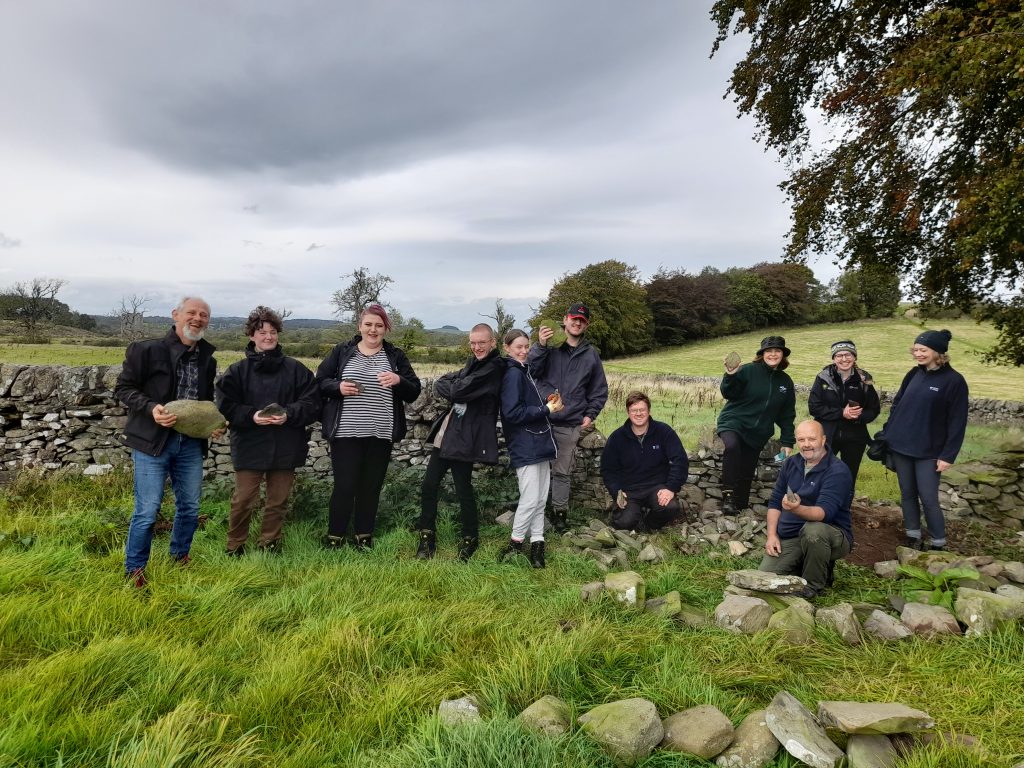Nature restoration: behind the scenes at Threave Estate
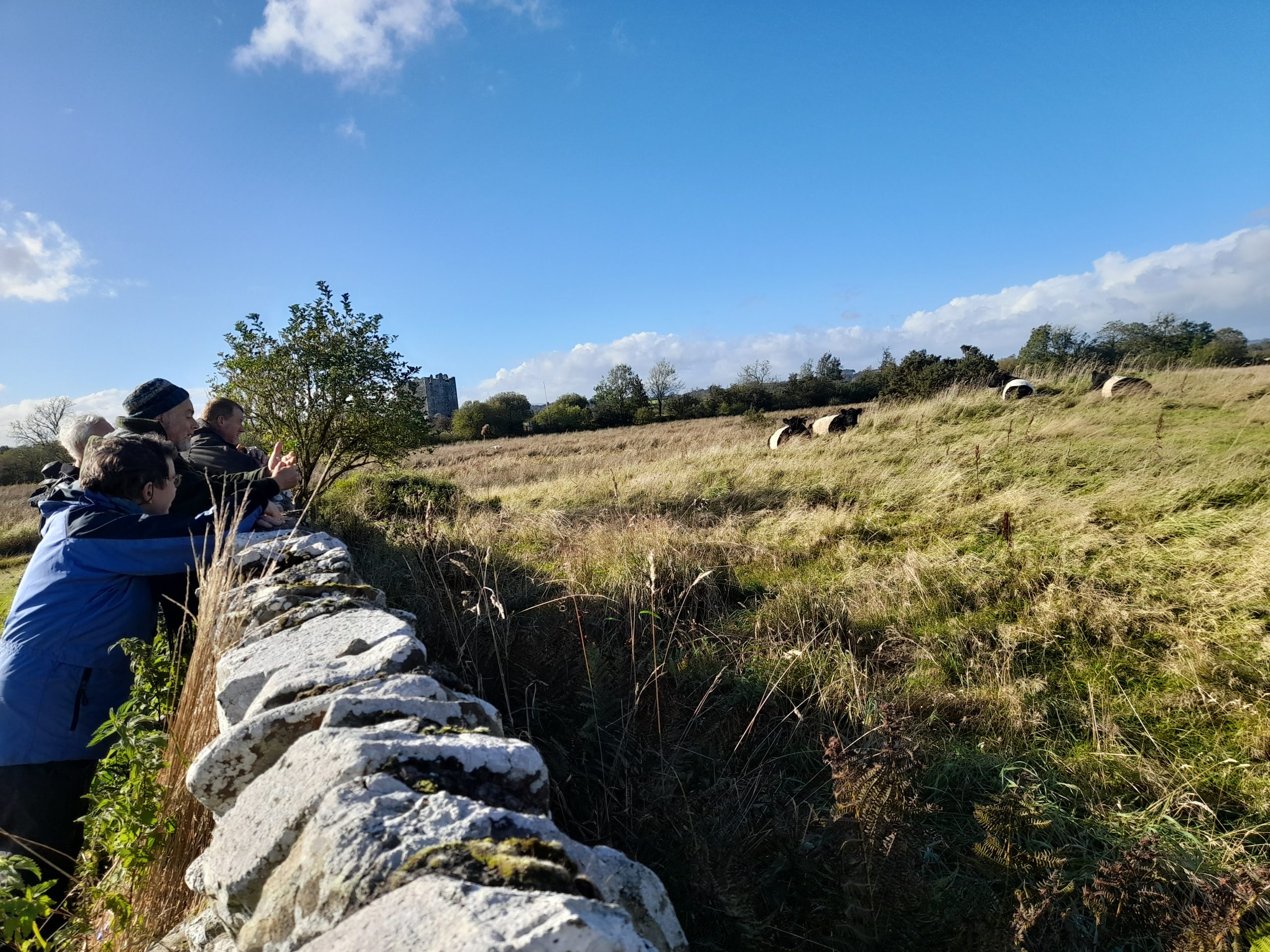
Kelton Mains, Threave Estate.
I’ve had the good fortune of being invited to Kelton Mains, Threave Estate, several times in the past few weeks. Firstly, for the ever educational and highly interesting Regenerative Farming Network talk, and secondly to meet with some of the brilliant students from SRUC studying Countryside Management.
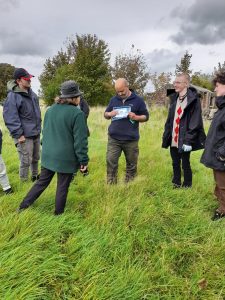 Threave Estate is managed by David Thompson and his team of rangers – Mary and Phil. Between them they are managing the habitats, keeping access open, sharing their vast knowledge with the public and always looking to the future for the estate. Over the past few years the land has been, and continues to be, on a process of re-naturalising with its surroundings. After being intensively farmed for generations, the land has relaxed and is beginning to show signs of change. One of the biggest things you’ll notice is so many of the fences have been removed – this means the wide-open spaces welcome you in, but also remind you of how small you are. It also allows the cattle to roam more freely and naturally, and the herd of Belted Galloways is currently trialling ‘No-Fence’ technology. This involves GPS tracker collars that make a buzzing noise when the cows wander to the edge of a pre-defined ‘invisible fence’ – they quickly learn that if they move away, the noise stops. The Regenerative Farming Network gathered at Kelton Mains on a rainy Friday afternoon to discuss the setup, the benefits and the potential blockers to this technology being widely implemented. Huw Connick has been working closely with the estate to plan and implement the trial and shared his vast experience with the group – this time, made up of poultry farmers, sheep farmers, market gardeners, smallholders and people who are just interested. We talked for hours and could have gone on much longer, and there was agreement that whilst the technology is initially expensive to set up, the benefits for conservation management and, in some cases, farming would be excellent. The cons being the capital cost, the need to replace batteries having potential to be labour intensive, however you could say the same about any aspect of livestock management.
Threave Estate is managed by David Thompson and his team of rangers – Mary and Phil. Between them they are managing the habitats, keeping access open, sharing their vast knowledge with the public and always looking to the future for the estate. Over the past few years the land has been, and continues to be, on a process of re-naturalising with its surroundings. After being intensively farmed for generations, the land has relaxed and is beginning to show signs of change. One of the biggest things you’ll notice is so many of the fences have been removed – this means the wide-open spaces welcome you in, but also remind you of how small you are. It also allows the cattle to roam more freely and naturally, and the herd of Belted Galloways is currently trialling ‘No-Fence’ technology. This involves GPS tracker collars that make a buzzing noise when the cows wander to the edge of a pre-defined ‘invisible fence’ – they quickly learn that if they move away, the noise stops. The Regenerative Farming Network gathered at Kelton Mains on a rainy Friday afternoon to discuss the setup, the benefits and the potential blockers to this technology being widely implemented. Huw Connick has been working closely with the estate to plan and implement the trial and shared his vast experience with the group – this time, made up of poultry farmers, sheep farmers, market gardeners, smallholders and people who are just interested. We talked for hours and could have gone on much longer, and there was agreement that whilst the technology is initially expensive to set up, the benefits for conservation management and, in some cases, farming would be excellent. The cons being the capital cost, the need to replace batteries having potential to be labour intensive, however you could say the same about any aspect of livestock management.
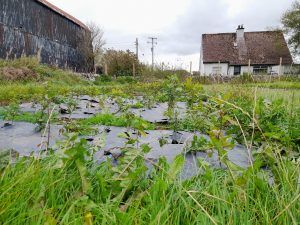 The next time I was at Kelton Mains, Dave showed me round some of the tree planting they’ve been doing. Focusing on native broadleaved trees and those which will be tolerant of water, the team have established pockets of saplings that will grow into sheltered copses. Scrapes have been carved out for water birds and ponds created for amphibians, plants and any wildlife that may need it. One of the ponds had sprung a leak and it wasn’t long before Dave had it fixed up again (about 6 minutes by my count), filling the gap with clay and rushes to block the outpour into the stream. Within minutes the leak had been turned into a micro-pond, and by the next day the whole pond was fuller and higher than before. The students arrived just after we fixed the leak, and we were all put to work straight away.
The next time I was at Kelton Mains, Dave showed me round some of the tree planting they’ve been doing. Focusing on native broadleaved trees and those which will be tolerant of water, the team have established pockets of saplings that will grow into sheltered copses. Scrapes have been carved out for water birds and ponds created for amphibians, plants and any wildlife that may need it. One of the ponds had sprung a leak and it wasn’t long before Dave had it fixed up again (about 6 minutes by my count), filling the gap with clay and rushes to block the outpour into the stream. Within minutes the leak had been turned into a micro-pond, and by the next day the whole pond was fuller and higher than before. The students arrived just after we fixed the leak, and we were all put to work straight away.
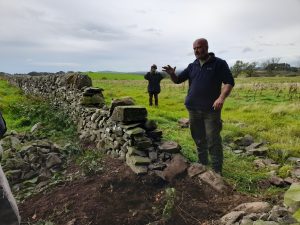 Dry-stone walling or dry-stone dyking is a traditional practice to maintain boundaries in the landscape, but they also provide much benefit to wildlife. Birds and bats use them as sight lines to navigate the countryside, small mammals shelter and squeeze through gaps and plenty of invertebrates hide in the cracks and crevices. It also shows off the geology of the region, as each place will use its own local stone, which here is greywacke (sedimentary sandstones) and granite (intrusive igneous). After an introduction and safety briefing from Dave, the students were quick to spot the places which needed rebuilding and started to remove unstable material – organising it by top stones, through stones and filling material. It’s hard work but keeping these crafts and skills alive is very much important to our cultural heritage, especially as Galloway has its own distinctive walling styles which may otherwise be lost. Once rebuilt these walls will withstand decades of weather, leaving a legacy of the hard work put in by those dedicated enough to learn the craft.
Dry-stone walling or dry-stone dyking is a traditional practice to maintain boundaries in the landscape, but they also provide much benefit to wildlife. Birds and bats use them as sight lines to navigate the countryside, small mammals shelter and squeeze through gaps and plenty of invertebrates hide in the cracks and crevices. It also shows off the geology of the region, as each place will use its own local stone, which here is greywacke (sedimentary sandstones) and granite (intrusive igneous). After an introduction and safety briefing from Dave, the students were quick to spot the places which needed rebuilding and started to remove unstable material – organising it by top stones, through stones and filling material. It’s hard work but keeping these crafts and skills alive is very much important to our cultural heritage, especially as Galloway has its own distinctive walling styles which may otherwise be lost. Once rebuilt these walls will withstand decades of weather, leaving a legacy of the hard work put in by those dedicated enough to learn the craft.
The students will be back in a few weeks’ time to finish the work, and if you’re interested in seeing the walls, the castle, the ponds and the wildlife for yourself then do visit the Threave Estate. There is a rolling programme of talks and events, and we’ll share them to our social medias as and when they happen. The extensive network of paths around the site will show you everything you need to see, so bring your binoculars, keep your dogs on leads (to help protect the birds) and enjoy the adventure. There’s much more to come from the Threave Estate too, with a community tree nursery beginning to take form, monitoring of plants and invertebrates across the site and soon the return of the geese. Keep up to date via their website and Facebook page.
Mary Berry, Land Use Advice Officer – mary@gsabiosphere.org.uk
